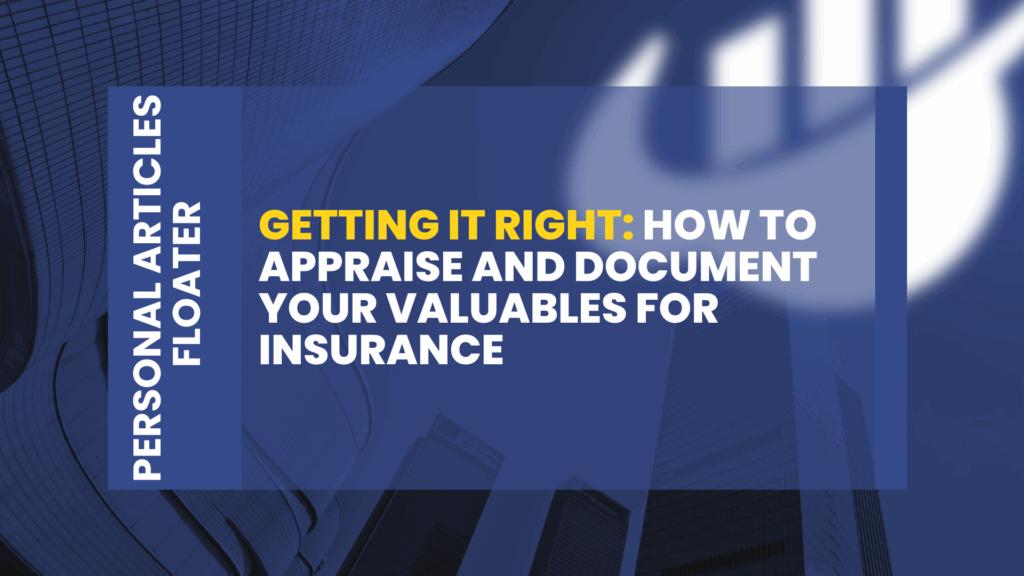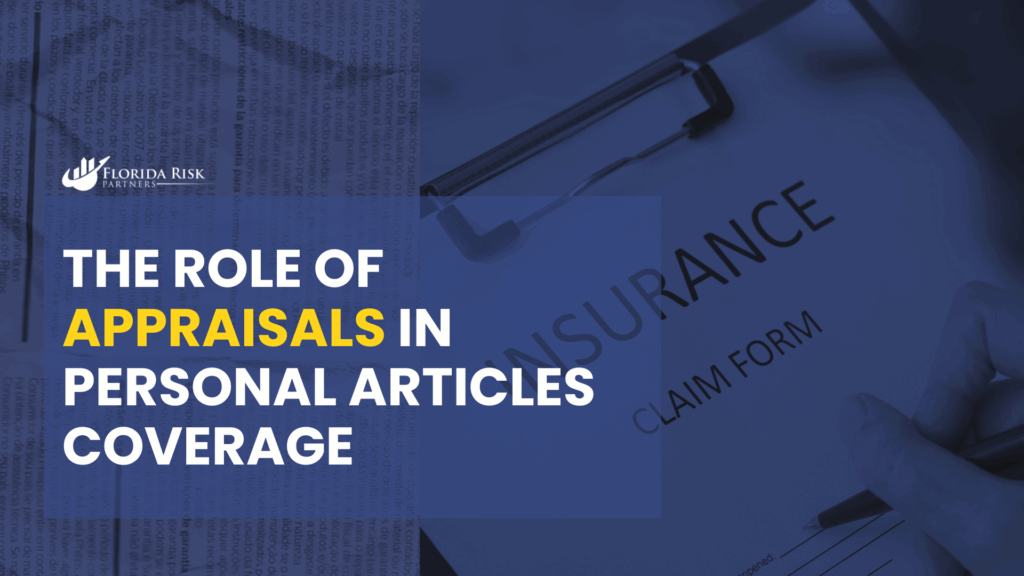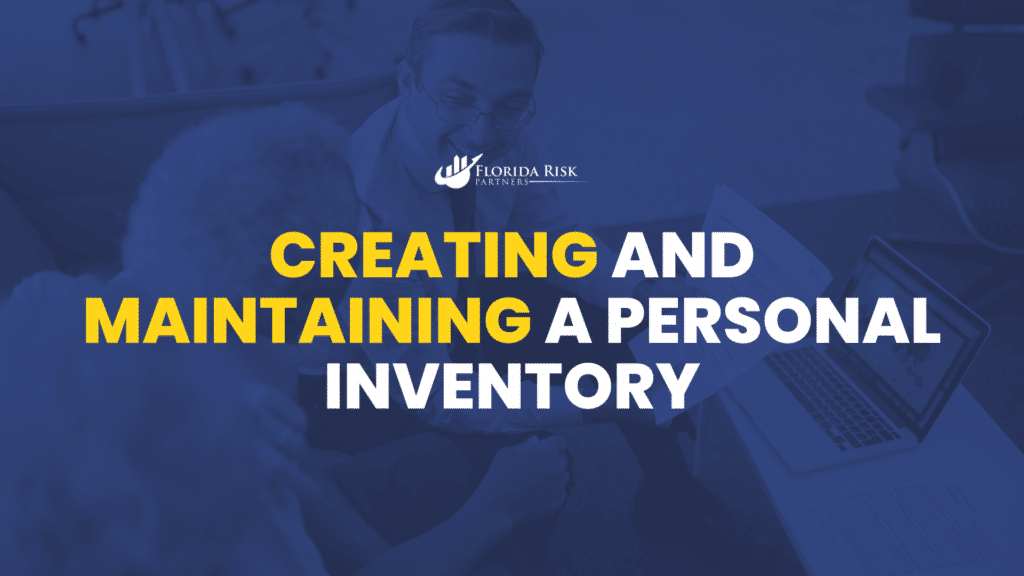-
Main Office: 1434 E. Bloomingdale Ave Valrico, FL 33596-6110
-
Phone: (888) 601-6660
-
Email: info@floridariskpartners.com

If you’ve been following along with our 12-week series on Personal Articles Floaters, you already know that this type of coverage is designed to protect high-value personal property—items like jewelry, collectibles, artwork, musical instruments, and more. And while choosing the right coverage type (scheduled or blanket) is a vital part of the process, one of the most important and often overlooked steps is proper documentation—starting with appraisals.
The truth is, even the most comprehensive insurance policy won’t be effective if the insurer can’t verify the value, ownership, or condition of the items you’re trying to protect. That’s why having a clear, accurate, and up-to-date record of your belongings is essential.
This week, we’ll walk you through how to appraise your valuables, what documentation you need, and how to create a reliable personal inventory that will make your claims process smoother, your coverage more accurate, and your peace of mind stronger.
Why Proper Documentation Matters So Much
Imagine losing a valuable piece of jewelry, only to have your claim delayed—or even denied—because you can’t prove its value. Or consider trying to file a claim on a stolen painting with no record of when it was purchased, what it was worth, or even a photo to prove you owned it. These situations happen more often than you might think.
Proper documentation serves three key purposes in the insurance world:
- It helps you determine how much coverage you actually need.
- It provides proof of ownership and value when filing a claim.
- It reduces disputes, delays, and underpayment issues during the claims process.
Whether you’re purchasing a Personal Articles Floater or reviewing your existing homeowners policy, documentation is the foundation upon which your financial protection is built.
The Role of Appraisals in Personal Articles Coverage
Let’s start with appraisals, which are a professional evaluation of an item’s market or replacement value. Not every item needs to be appraised to be covered under a floater, but many insurance companies require or recommend appraisals for high-value items—especially when those items are scheduled individually.
When Are Appraisals Required?
Most carriers require appraisals for:
- Jewelry valued above a certain threshold (usually $2,500–$5,000)
- Fine art
- Antiques
- Rare collectibles
- Musical instruments of high value
- Luxury watches
Appraisals are typically not required for blanket coverage, unless a claim is filed, at which point proof of value may still be necessary.

What an Appraisal Includes
A quality appraisal should include:
- A detailed description of the item (materials, maker, condition)
- High-resolution photos
- The current market value or replacement cost
- The appraiser’s name, credentials, and contact information
- The date of the appraisal
It’s important that the appraiser is qualified and, if possible, certified by a recognized organization such as:
- Gemological Institute of America (GIA) – for jewelry
- American Society of Appraisers (ASA)
- International Society of Appraisers (ISA)
- National Association of Jewelry Appraisers (NAJA)
How Often Should You Re-Appraise Your Valuables?
Many people get one appraisal and assume that’s enough. But over time, values change. The market for precious metals, artwork, antiques, and collectibles fluctuates. Your $7,000 engagement ring from 10 years ago could be worth $9,000 today—or maybe only $5,000. Without a current appraisal, you could be overpaying for coverage or underinsured when it matters most.
Best practice: Reappraise high-value items every 3–5 years, or any time there’s a major market shift, change in condition, or after significant damage and repair. Your insurer may request updated valuations periodically, especially for items with values exceeding $10,000.
Other Forms of Documentation You Should Maintain
While appraisals are the gold standard, you don’t necessarily need them for every item. For many mid-value items—especially those grouped under blanket coverage—other forms of documentation are acceptable and helpful, such as:
1. Receipts and Purchase Records
These are essential for newer items. A purchase receipt shows the price paid, the date of acquisition, and the retailer—useful for determining replacement cost and establishing ownership.
2. Photographs
Take clear, high-quality photos of each item. Include different angles and, where applicable, take close-ups of serial numbers, engravings, hallmarks, or labels. Photograph the item both by itself and in its usual location (e.g., jewelry in a box, artwork on the wall).
3. Serial Numbers and Model Information
This is especially important for electronics, instruments, and luxury items. Record serial numbers, model names, or production numbers and store them in a document or spreadsheet.
4. Certificates of Authenticity
If you own fine art, collectibles, or luxury goods, certificates of authenticity can support your claim and help prevent disputes about legitimacy or value.
5. Owner’s Manual or Product Registration
Especially for electronics and specialty equipment, these documents can help verify details and assist in determining accurate replacement cost.
6. Repair or Maintenance Records
For musical instruments, watches, and antiques, records of restoration or servicing can support value and confirm condition prior to loss.
Creating and Maintaining a Personal Inventory

Now that you understand what to document, let’s talk about how to organize and maintain this information.
A personal property inventory is a comprehensive list of your belongings, including:
- Item name and description
- Purchase date and price
- Estimated or appraised value
- Serial numbers or identifying marks
- Supporting documents (receipts, photos, certificates, etc.)
How to Create Your Inventory
Step 1: Walk through your home, room by room.
Start with obvious valuables: jewelry, electronics, instruments, designer fashion, collectibles, art, and furniture. Don’t forget storage closets, safes, or off-site storage units.
Step 2: Use a spreadsheet or inventory software.
There are plenty of tools and apps available, or you can simply use Excel or Google Sheets. Make sure to include fields for description, value, serial number, documentation, and insurance status.
Step 3: Add photos and backup the file.
Save your inventory to the cloud, an external hard drive, or email it to yourself. Keep printed copies in a fireproof safe or safety deposit box.
Step 4: Update regularly.
Set a calendar reminder to update your inventory at least once a year and any time you acquire or dispose of a valuable item.
What If You Don’t Have Documentation?
If you’ve already acquired valuable items but don’t have receipts or appraisals, don’t panic. You can still take steps to improve your documentation:
- Start with photos—they’re better than nothing.
- Write a description of when and how the item was acquired.
- Estimate value using market research or ask a professional for a valuation.
- Schedule an appraisal if the item’s worth justifies the cost.
- Talk to your insurer—they may accept partial documentation or advise you on next steps.
It’s never too late to build a paper trail.
The Insurance Company’s Perspective
Why do insurers care so much about documentation? Because it protects everyone involved.
For insurers, it reduces fraud risk and helps them settle claims fairly and quickly. For policyholders, it ensures they get compensated accurately and promptly. The claims process becomes smoother and less adversarial when both sides agree on what was owned and what it was worth.
When you provide strong documentation, you’re empowering your insurer to act quickly and generously—because you’ve removed the guesswork.
Tying Documentation Back to Coverage
Proper documentation isn’t just about getting your money back. It’s also about setting your coverage up correctly in the first place. Without knowing the value of your items, you can’t:
- Determine if you need a floater
- Choose between scheduled and blanket coverage
- Ensure you’re not underinsured or overpaying
- Update your policy after a loss or acquisition
By investing time in documentation now, you’re making your coverage smarter, your premiums fairer, and your claim experience smoother.
Use Our Free Resource to Get Started
We’ve created a downloadable tool to help you start your inventory and documentation process. It includes:
- A personal property checklist
- Inventory template
- Photo tracking guide
- Appraisal tips
- Coverage planning questions
Final Thoughts: Documentation Is Protection
At the end of the day, insurance is a promise—a promise to restore you to the position you were in before a loss. But that promise only works if both you and your insurer know what that position was. That’s why documentation matters.
Whether you’re protecting a $20,000 necklace, a $6,000 cello, or a collection of vintage watches, having the right records in place means you’ll get what you deserve—and you’ll get it faster, with less stress.
If you haven’t reviewed your documentation or appraisals in years—or ever—now is the time. We’re here to help.
Next week, we’ll be shifting gears and talking about how personal articles coverage protects your valuables even when you travel. You won’t want to miss it.
Call Us Or
Schedule an Appointment
Select an agent below to view our online calendars and select a day and time that works best for you or call us directly at 888-601-6660. When you use our online calendars, you will receive an email with more information.



